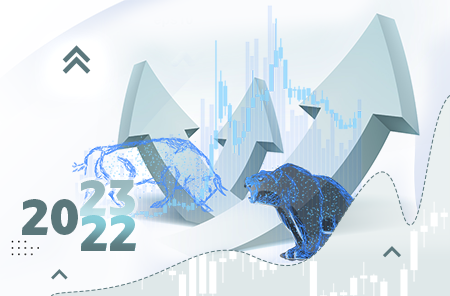Trading Conditions
Products
Tools


When looking back at 2022, these were the factors that shaped the markets: runaway inflation, energy crisis, and increased market volatility. We can say that the third factor has been the consequence of the other two.
Inflation became an issue as the global economies were trying to save themselves from the effects of the Covid crisis - by stimulating their economies with low interest rates and loose monetary policies. At the macro level, supply chain issues and parts shortages have had the effect of inflating the cost of factory goods as the global economy was coming out of the pandemic recession. Another factor behind the rising inflation was a surge in consumer spending fueled by federal stimulus checks given out during the pandemic and the low interest rate loans offered by banks. These are also the key factors that drove the reaction of the markets at the beginning of 2022.
FED no longer backing the markets
To stave off the effects of Covid on the economy, the American Central Bank FED has pumped 120 billion USD a month in assets into the market. In the last 2 years, 25% currency supply in circulation has been printed. Over 2022 that liquidity has been pulled from the market as FED became alarmed by growing inflationary pressures. As a reaction to try to control the emerging inflation, the FED has embarked on a policy of gradual interest rate hikes. Periods of lower and higher interest rates is something that is cyclical and thus FED has merely ushered in the cycle of rate hikes. This comes in stark contrast to the loose monetary policy adopted over the past 2 years by central bankers who have found themselves competing against each other in lowering the rates to support their economies. Thus from the start of 2022 onward, the name of the game became the exact opposite - who restricts the monetary policy the fastest and by the greatest measure.
Central bankers intervene
Inflation in the US hit 7.9%, and has seriously started to occupy the politicians and drove action to do something about it. FED started to realize that inflation is not transient and is here to stay. ECB has also started to adopt a similar rhetoric. FED had to take into account the hundreds of millions of citizens who were voicing concerns over inflation and took priority as an issue even over the unemployment figures, which stood around 3.8 %. The FED had to react in exactly the opposite way than it did during the Covid crisis where it chose to stimulate the economy with ample and cheap liquidity. Already in February 2022 – the ECB was also facing inflationary pressures across the Eurozones’ economies - entertaining the possibility of raising interest rates. The primary mission of central bankers globally became controlling inflation – and everything became subjugated to this goal.
Technical correction and start of bear market
The general sentiment in January 2022 was that stocks are going to go up, and as we know the exact opposite happened. Instead, the FED was forced to adopt a restrictive monetary policy. Gradually, as a result, the chain of events driven by the central banks, we have found ourselves in a bear market where the markets have declined by about 20% from all-time high. The same was the case on DAX – a decline over 20% from all-time high. Trading in the 2022 bear market can be characterized as trading in a bear market chop - where most of the action is characterized by frequent swing highs and swing lows.
Needless to say, the sentiment on S&P, oil markets, even cryptocurrencies continues to serve as an indicator of investor apprehension on the global markets, as yet we have not seen the bottom of this market.
Outlook for 2023
A lot of the trends we have seen over 2022 are here to stay - they will simply be carried over to 2023. In terms of the trends observed over 2022, the biggest question on everyone’s lips has been has the market reached the bottom?
Similarly to 2022, we can dub 2023 the year of the continuing chop. It is the view of our analysts that we will continue to see relatively high market volatility into next year. This is what we can say with a high degree of certainty. What we cannot exactly predict is how high the FED will push the interest rates or what will be the situation on the job market.
One, albeit distant possibility is that over 2023 we may even see the FED hike the rates above 5.5%. If such a scenario materializes, the FED will be coming down with the rates no sooner than 2024. This would however come quite as a shock to the markets and we would see a downward trend, if not a spiral, in stocks and indices.